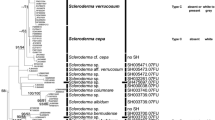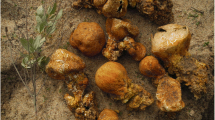Abstract
The mycorrhizal status of Adenostoma fasciculatum, the dominant shrub in California chaparral, has been unclear. In two typical, nearly monospecificstands, A. fasciculatum was found to have arbuscules and intercellular hyphae. Antisera detected hyphae of the arbuscular mycorrhizal (AM) fungal genera Acaulospora, Glomus, and Scutellospora, although we found only spores of Glomus. Some roots had partial sheaths and inter- and intracellular septate fungi without indications of root necrosis. Ectomycorrhizal root tips were also found, including Cenococcum and other unknown taxa. Sporocarps of EM fungi including species of Rhizopogon, Pisolithus, Balsamia, Laccaria, Hygrophorus, and Cortinarius were found in the stand, with no other EM or arbutoid mycorrhizal plants nearby. These observations indicate that A. fasciculatum forms mycorrhizae with AM, septate, and EM fungi, but often fails to form easily recognizable mycorrhizal structures.
Similar content being viewed by others
Author information
Authors and Affiliations
Additional information
Accepted: 5 September 1998
Rights and permissions
About this article
Cite this article
Allen, M., Egerton-Warburton, L., Allen, E. et al. Mycorrhizae in Adenostoma fasciculatum Hook. & Arn.: a combination of unusual ecto- and endo-forms. Mycorrhiza 8, 225–228 (1999). https://doi.org/10.1007/s005720050238
Issue Date:
DOI: https://doi.org/10.1007/s005720050238




